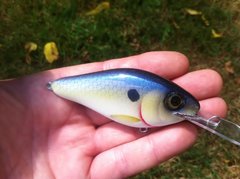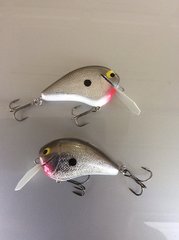-
Posts
5,782 -
Joined
-
Last visited
-
Days Won
193
Content Type
Profiles
Articles
TU Classifieds
Glossary
Website Links
Forums
Gallery
Store
Everything posted by BobP
-
I fill the hole by cutting a little patch out of a pop can with scissors and superglue it over the hole. The aluminum is soft enough to easily sand it down before painting and thin enough to be unobtrusive. If you are just adding bb's or lead shot a dab of epoxy putty will plug a small hole. The paint and topcoat will reinforce and waterproof it.
-
I've used tung oil on furniture. It's very tough after it completely dries but it takes literally weeks to reach end state so I wouldn't consider it for a wood lure since there are other options.
- 2 replies
-
- hardening
- durability
-
(and 1 more)
Tagged with:
-
Try a short 15# or greater mono or fluoro leader.
-
All topcoats have toxic properties, including epoxies. Fewer people are affected by epoxy but some develop skin sensitivity to it. All topcoats ending in "thane" contain solvents that are unhealthy. Two part automotive urethane topcoats contain isocyanates that are extremely toxic. Whatever you use, you should consider measures to prevent being affected. That isn't hard to do with most topcoats available to the consumer market. Good ventilation and keeping the topcoat at arm's length is sufficient for most hobby users. But remember that the toxic effect depends not only on the concentration but also the frequency of exposure.
-
Ddl, lots of classic custom wood baits were coated with polyurethane through the years. It was one of the good choices available. But times change and coatings chemistry has changed to include more durable finishes that are tougher and non-yellowing. Guys like them to make lures that fish longer before the inevitable happens and the lure self destructs. That doesn't mean polyurethane is a no-no if it fits your style of building and you are happy with its performance, especially if the newer options like uv or moisture cured "thanes" are too much of a hassle, or too expensive, which they certainly can be for some. There's no perfect topcoat for every builder and every bait.
-
If Alumi-UV cures hard without wax flakes, and I trust that it does, it has to be the fastest tough clearcoat without a drawback. It does seem to be considerably more expensive than the other choices mentioned. That doesn't mean I'll throw away my epoxy and MCU but I'd like to try it in the future. Thanks for the review Anglinarcher.
-
I think you also have to consider film thickness when you compare epoxy and Mcu durability. I use Devcon 2T epoxy and Dick Nite MCU. One coat of epoxy or two of MCU and they both work fine on a typical bass crankbait. But the epoxy is several times thicker than the MCU. When I make baits specifically for trolling, the epoxy lasts longer against hook rash wearing down to the wood than the MCU does. Not because it's harder or tougher, just because it's much thicker. So yes the epoxy is more durable in a practical sense for that application. However if the coating thicknesses were identical I have no doubt MCU would last longer. For clarity, gloss, and resistance to yellowing, MCU wins hands down. All these attributes are important and there are always trade offs among finishes. You have to rank them according to your particular likes/dislikes.
-
JMHO, moisture cured urethane (KBS Diamond coat or Dick Nite) or UV cured polyester resin (Alumi-UV) are probably the toughest topcoats. In practical terms, durability also depends on film thickness. A single coat of Devcon Two Ton epoxy or several coats of Envirotex Lite epoxy can be just as durable against hook rash just because they are thicker.
-
-
Smallmouthaholic, I've never been very happy using epoxy on lead lures. It tends to be viscous and forms a coating that seems too thick to me. Plus if the lead has any sharp edges, epoxy will pull away from them during curing and leave a thin coating that will quickly wear away under heavy use, e.g. a jig head. Personally, I like a moisture cured urethane on metal or lead lures. KBS Diamond coat or Dick Nite S81 gets my nod. They form a thin tough coating that adheres well to metals and is chip resistant.
-
There shouldn't be a problem if you're topcoating with D2T. If you topcoated with something containing a solvent it may or may not react with the solvent in the Krylon, but that shouldn't be a problem here since D2T doesn't.
-
Dale, KBS Diamond Coat is a one part moisture cured urethane. A polymer is defined as any heavy molecule made up of smaller molecules, so I guess KBS may become a polymer as it cures and its molecules crosslink. But I think epoxy is a different two part formulation that forms its polymer through interaction of its resin and hardener. You're certainly right that MCUs like KBS are becoming more popular for bait top coating. Thin, tough, glossy, waterproof and simple to apply. But not without some storage, handling, and coating regimen limitations.
-
3 brands are popular among lure builders. Bob Smith, Devcon Two Ton, and Envirotex Lite (aka Etex). All of them work well and each has a different set of peculiarities as far as the best application technique, etc. if you want simple one coat coverage, Bob Smith or Devcon are usually preferred.
-
I'm not sure what breaking a line tie with pliers tells you as far as how durable the line tie would be on a bass crankbait. I can only report that no bass, striper, or pike has ever broken or deformed a hanger or line tie on one of my baits. I use soft temper .041"stainless wire which is a little harder than soft brass wire and I only put 20 gauge (.032") wire on very small baits that are less than 2" long. personally, I never was happy with the difficulty in accurately bending hard temper stainless wire with hand tools and was super happy when I tried soft temper wires. It has other advantages than just ease of working it, as I mention above. In the end every builder has to judge for himself what is good enough for his baits.
-
I think .88 mm is .034", thinner than the .041" wire which is similar to the wire used on "old style" balsa crankbaits. Yes it is what we mean by soft temper wire though I don't know the specific temper state of that particular brand wire. I like the Malin brand wire sold by McMaster-Carr.
-
If your paint pen is solvent based, the Krylon is also and that is causing the paint to run. Switch to a water based paint pen.
-
Guess it depends on how many of one lip you need. A die isn't easy or cheap. As a hobby builder I use templates to draw the shapes on polycarbonate or circuit board, then do a rough cut with straight cut Wiss metal shears followed by sanding down to the exact shape with a Dremel tool and a fine grit sanding cylinder. Then buff the edges with a felt cylinder. The shears easily cut the 1/16" polycarbonate and the 1/32" circuit board I use. It takes me about 10 minutes per lip. The critical part is having an accurate template. I use a freeware CAD program to draw the shape and print it out. This insures a symmetrical template. Then I trace the template onto more durable clear plastic. This also gives you a library of templates over time to choose from for future lips.
-
8860K15 is the item I order. It's annealed stainless 302/304 type wire in a 1/4 lb spool 55' long. Price is between $6-$7. thendiameter is .041"
-
Either their site or my ISP provider is super slow right now, so can't get through the menus but I think the "bend and stay" wire in 304 stainless wire is the one I order. My last order was for the .040 " wire in a 50' spool and cost less than $10. They have used different names for the soft temper wire over the last few years, from "safety wire" to "soft temper", etc. when the site speeds up again, I'll check.
-
Just from my limited experience with various wire types, I think soft temper brass is slightly softer than soft temper stainless steel. I prefer the steel because it won't discolor over time. If you are building wood baits with the line tie in the nose of the body a soft temper wire is a definite advantage because you can bend the line tie easily to tune the bait without breaking the lure's finish and causing the lure to leak. I use soft temper wire on all baits. On baits where the line tie is out on the lip surface, soft wire lets me twist and bend the line tie accurately for a neat application and allows the user to tune the line tie without hogging out the hole in the lip and ruining the bait. Soft temper wire seems very bendable compared to hard temper stainless, and it is. But when bent into a small circle for a hardware application it is surprisingly strong. I've never had a bass break or deform a line tie or hook hanger made from the stuff and man, is it a pleasure to bend, twist, and shape compared to hard temper stainless. Just my 2 cents.
-
After the epoxy is hard enough not to sag, there's no reason it has to stay clipped to the rotator. Take it off and use some wire to hang it up. I don't coat baits while they are clipped to the rotator. I use locking forceps to hold them while brushing and then clip them on the rotator. Then there's not so much chance of globing it around the clip.
-
Epoxy tends to draw away from any sharp edge while curing. It looks ok but is very thin at the edge and quickly wears away during fishing. You can round over the edges or switch over to a different topcoat. I haven't tried Aluminum-UV but it is a VERY quick topcoat and very tough. I also like and use moisture cured urethane. It's thin, water clear, and tough too. But it has handling and storage limitations that need to be considered. Anglinatcher: how is the clarity on Aluminum-UV? Any white blush from wax flakes?
-
I use soft temper stainless .041" wire for typical size bass baits. It's easy to form and twist, makes the line tie easy to tune, and is plenty strong enough for bass, even stripers. I go down to .031" wire for small cranks less than 2". I've also used Malin saltwater leader wire #12 which is thinner and harder temper but still softer than hard temper stainless wire. It is 190# test and comes in a brown "stealth" finish. I order soft temper stainless wire from McMaster-Carr online.
-
I think "pour-on" epoxies like Etex will eventually outgas their solvent, so doubt that extending the recoat time would have any appreciable effect regarding the epoxy reaching its final cure state. It probably just takes as long as it takes, reportedly about a week. I don't know whether the solvent content contributes to the heat softening you described before final cure is achieved (you didn't say how soon after coating the lure you fished it). I bet you are glad you fished the lure when you did, regardless of the cure state. It will only get harder now if you jumped the gun by a few days, so I wouldn't worry about it. Nice musky!







